Inventory control is an important technique for organizations to guarantee that they have the proper amount of goods to satisfy demand without overstocking or understocking. Efficient inventory control reduces extra expenditures, optimizes storage, and enhances overall operations. However, businesses frequently confront issues such as inaccurate tracking, stockouts, and inefficiencies, which can interrupt operations and reduce customer satisfaction.
As firms develop and market demands fluctuate, good inventory control becomes increasingly important. Businesses can reduce losses, eliminate stock outs, and assure the seamless operation of their supply chain by implementing effective tactics. This article will discuss the necessity of inventory control, the distinctions between inventory control and management, typical obstacles, and tried-and-true approaches for improving this critical business function.

1. What is Inventory Control?
Inventory control is an important aspect of business management since it ensures that organizations always have the right amount of merchandise on hand. It entails managing inventory in such a way that it satisfies demand without overstocking, which can result in increased prices. Proper inventory control enables firms to avoid stockouts, decrease waste, and increase cash flow. The process involves a variety of tactics and technologies for tracking inventory movements, forecasting demand, and maintaining an effective supply chain.
Businesses that manage inventory correctly can assure smooth operations, increase customer happiness, and lower operating expenses. This article delves into the significance of inventory control, the distinctions between inventory control and management, common inventory control issues, and the most effective strategies and tools for streamlining this vital operation.
2. The Importance of Inventory Control for Businesses
Inventory control is vital for firms to run efficiently and profitably. Businesses can avoid production or sales delays by keeping proper stock levels, as well as stockouts and surplus inventory. Proper inventory management optimizes the supply chain, lowers costs, and increases profitability.
In today’s competitive industry, inventory management is critical to consumer happiness. Keeping popular products in stock builds customer trust and loyalty. Without it, firms risk experiencing delays, missing orders, and revenue losses. Effective inventory control also allows for more informed decisions about sourcing, sales, and general business strategy.
a. Reduces Overstocking and Stockouts
Effective inventory control allows businesses to balance stock levels by preventing overstocking and stockouts. Overstocking incurs additional storage costs and potential waste, whilst stock outs result in lost revenue and consumer discontent. Businesses that effectively estimate demand and monitor stock levels can maintain an appropriate inventory balance that fulfills consumer expectations without incurring excessive costs.
Furthermore, good demand forecasting enables businesses to change their stock in response to market trends, ensuring they avoid the traps of both excess and shortfall. This balance boosts profitability by reducing waste and increasing sales opportunities.
b. Improves Cash Flow
Effective inventory control increases cash flow by preventing capital from being locked up in unsold goods. Businesses that manage stock levels efficiently might free up resources for other operational purposes. This method allows organizations to invest in areas such as marketing, innovation, and expansion, increasing overall flexibility. Well-managed inventory can also make businesses more appealing for business grants to fund future growth.
Businesses use tactics such as just-in-time inventory to maintain only the stock they need, minimizing unnecessary storage expenditures. This strategy decreases the danger of overinvestment in low-demand items, hence improving cash flow. Furthermore, effective inventory management improves resource allocation, boosting the chances of qualifying for business funding.
c. Enhances Customer Satisfaction
Inventory control ensures that businesses have the right products available at the right time, which is crucial for meeting customer demand. Businesses that maintain proper stock levels can reduce lead times and fulfill orders more quickly, thereby improving the customer experience. This leads to enhanced customer satisfaction, loyalty, and repeat business.
Furthermore, constantly meeting client demands strengthens a company’s dependability and reputation. Customers are more inclined to return if they believe things will always be available when they need them, which increases brand loyalty and satisfaction. According to Forbes, organizations that prioritize inventory management and keeping stock levels in line with consumer demand are better positioned to develop long-term client loyalty and satisfaction.
d. Optimizes Storage Costs
Proper inventory control enables firms to manage storage expenses by keeping inventory levels in line with demand. Overstocking increases storage prices, but understocking might create delays or operational problems. Businesses can save money on storage by tracking stock levels and modifying them to meet actual demand.
Efficient inventory control also guarantees that enterprises do not have surplus stock that will go unsold, eliminating the need for larger storage facilities. This simplifies the entire supply chain and eliminates superfluous operational expenses, resulting in better cost management.
e. Streamlines Operations
A well-organized inventory system improves business operations by minimizing supply chain delays and inefficiencies. Businesses that check their stock levels accurately can respond promptly to demand swings and maintain smooth production cycles. This reduces bottlenecks and ensures that resources are directed to where they are most needed.
Furthermore, an effective inventory system delivers real-time stock status updates, allowing firms to make more educated purchase and distribution decisions. This eliminates operational friction, increases communication, and speeds up the movement of commodities from suppliers to customers, resulting in overall increased efficiency.
3. Differences Between Inventory Control and Inventory Management
Inventory control and inventory management are sometimes used interchangeably, however they refer to different aspects of supply chain management. Inventory control is keeping adequate stock levels, monitoring inventory, and conducting audits to avoid stockouts or overstocking. Its purpose is to successfully balance stocks to satisfy demand without oversupply or scarcity.
In contrast, inventory management is a more comprehensive strategy that encompasses procurement, storage, distribution, and inventory control. It encompasses the entire inventory lifecycle, from sourcing to delivery, to ensure efficient product flow throughout the firm. For businesses such as construction, ERP modules for construction company can help streamline inventory management by integrating procurement, storage, and inventory control, thus increasing overall efficiency.
4. Main Issues in Inventory Control and Their Solutions
Effective inventory control is critical to ensuring corporate operations run smoothly and profitably. However, organizations regularly face a number of issues that interrupt inventory management, resulting in inefficiencies and financial losses. Poor inventory control can have an impact on everything from cash flow to customer happiness, and without adequate management, issues like stockouts, overstocking, and inaccurate tracking can occur.
As firms expand and supply networks get more complicated, addressing these concerns becomes increasingly important. The following are some of the most typical inventory control issues that firms confront, as well as effective solutions to them.
a. Overstocking and Understocking
Overstocking ties up important capital while also increasing storage costs and the risk of goods becoming obsolete, whereas understocking results in missed sales opportunities and consumer unhappiness. The balance between having enough stock to meet demand and not committing to surplus inventory is critical.
One of the most successful approaches to addressing this issue is to deploy Just-in-Time (JIT) inventory systems. JIT focuses on keeping only the necessary stock levels, allowing firms to order what they need when they need it. Demand forecasting technologies can also assist organizations predict future sales and manage stock levels accordingly, avoiding both overstocking and understocking.
b. Poor Inventory Tracking
Manual inventory monitoring can lead to errors and anomalies, making it difficult for firms to keep correct data. Incorrect stock counts can cause misunderstanding, overordering, or stockouts, all of which have a negative influence on both sales and customer happiness.
The solution to this challenge is to use automated inventory tracking technologies like barcode scanning or Radio Frequency Identification (RFID).
These tools provide businesses with real-time inventory visibility, cutting down on manual data entry and ensuring that their stock information is always reliable. Accurate tracking allows organizations to increase order fulfillment, optimize storage, and obtain better visibility into inventory turnover.
c. Inefficient Stock Rotation
In industries such as food, medicines, and electronics, incorrect stock rotation can cause obsolete inventory-outdated or outmoded products-to go unsold, resulting in waste and financial losses. An ineffective stock rotation method can also diminish inventory turnover and profitability.
To avoid this, organizations should use inventory management strategies such as FIFO (First In, First Out) or LIFO (Last In, First Out), depending on the products they manage. FIFO ensures that the oldest inventory is used first, decreasing waste and increasing stock turnover. These inventory rotation tactics assist organizations in staying organized and maintaining fresh supply, particularly for time-sensitive products.
d. Inadequate Supplier Relationships
An inconsistent supply chain can cause delivery delays and inventory shortages, disrupting sales and manufacturing plans. Without solid supplier ties, organizations may face unexpected lead times and stockouts, limiting their ability to satisfy client demand.
Strengthening supplier relationships through open communication and explicit agreements is critical to guaranteeing timely deliveries and better inventory replenishment. Businesses should also consider diversifying their supplier base to minimize relying on a single source, which lowers the risk of stock outages and improves supply chain resilience.
e. Lack of Real-Time Data
Access to real-time data is critical for making informed inventory management decisions. Without precise and up-to-date information, organizations may experience stock imbalances, ordering inefficiencies, and missed sales opportunities.
Implementing real-time inventory tracking software or combining inventory management systems with advanced analytics can provide firms with useful information about stock levels, sales trends, and overall inventory performance. Businesses can use these technologies to better alter their inventory plans, ensuring they fulfill client demand while reducing waste and overstocking. Real-time data allows for more accurate forecasting, better stock control, and faster decision-making, all of which improve corporate efficiency.

5. Inventory Control Techniques in Business
Effective inventory control systems are essential for firms to run smoothly and meet client demand. These tactics aid in inventory tracking, waste minimization, and storage space optimization, resulting in lower operational expenses and more customer satisfaction. The best technique varies according to the business type and supply chain complexity.
With technological developments, inventory control has expanded to encompass automated systems and real-time tracking technologies. These solutions simplify operations and enable data-driven decisions to improve inventory management. The following are eight regularly utilized approaches for helping firms improve their inventory control.
a. Just-in-Time (JIT) Inventory
The Just-in-Time (JIT) inventory system lowers inventories by ordering things just as they are required for manufacturing or sale. Close supplier coordination is required for timely delivery that adheres to production schedules. This reduces stockpiles, saves storage space, and lowers inventory expenses. JIT is suitable for businesses with variable demand, such as fashion and technology, according to Investopedia.
JIT lowers inventory holding costs, releasing capital that would otherwise be locked up in surplus goods. It helps to reduce the danger of product obsolescence and waste, particularly in fast-moving sectors. The method increases cash flow and operational efficiency. JIT preserves a competitive advantage by encouraging lean operations and supporting good stock management.
b. Economic Order Quantity (EOQ)
Economic Order Quantity (EOQ) is a technique for determining the best order quantity while minimizing overall inventory expenses. It balances ordering and holding costs by calculating the optimal stock level using mathematical calculations. This strategy prevents overstocking and ensures that businesses have just enough inventory to meet demand. By maintaining the proper balance, EOQ assists businesses in avoiding excess stock and costly storage.
EOQ facilitates cost-effective purchasing decisions by eliminating the requirement for excess inventory. It also lowers storage expenses by maximizing warehouse space. As a result, businesses can run smoothly without experiencing frequent stock outs or carrying surplus inventory. This technique promotes a more streamlined and effective inventory management process.
c. ABC Analysis
ABC analysis divides inventory into three value categories: A (high-value), B (moderate-value), and C (low-value). It directs management attention toward high-value issues that have a major impact on profitability. Businesses can ensure that their core items are constantly in stock by focusing resources on them. This strategy aids in the efficient allocation of resources, preventing overstocking and understocking.
Implementing ABC analysis improves resource utilization by focusing on valuable stock. It lowers inefficiencies and prioritizes high-value products in inventory management. This strategy enhances overall stock control by emphasizing the most profitable items. It enables organizations to streamline operations while preserving profitability.
d. First-In, First-Out (FIFO)
FIFO guarantees that older inventory is used or sold first, which is critical for reducing waste and spoilage, particularly with perishable commodities. This approach is commonly used in industries such as food and pharmaceuticals, where product shelf life is important. By prioritizing older stock, FIFO protects product quality and decreases the risk of obsolete items. It also helps organizations meet safety regulations by ensuring inventory is used in a timely manner.
This strategy reduces waste and avoids loss due to expired supplies. FIFO also improves inventory control by shifting older stock first. It ensures that clients receive fresh, high-quality products, which increases their pleasure. Furthermore, this strategy is straightforward to apply and beneficial in companies with time-sensitive products.
e. Last-In, First-Out (LIFO)
LIFO assumes that the most recently received inventory is sold first, which helps to manage costs in volatile markets. This strategy is effective in businesses where product prices are constantly changing, such as raw materials. It enables organizations to successfully manage expenses during inflation by prioritizing newer stock. LIFO can aid in accurately reflecting current market conditions in financial reports.
LIFO minimizes taxable revenue as inventory prices rise, which benefits firms financially. It also ensures that older inventory is available for long-term use. This strategy is particularly useful for controlling costs during periods of price volatility. However, it may not be appropriate for every industry.
f. Vendor-Managed Inventory (VMI)
Vendor-Managed Inventory (VMI) enables suppliers to directly monitor and manage inventory levels, assuring a consistent supply based on predetermined parameters. This decreases the operational burden for organizations by automating stock replenishment. VMI improves collaboration with suppliers and optimizes supply chain procedures, reducing stockouts. Businesses gain from a more efficient system when the duty for inventory management is transferred to suppliers.
This method reduces manual stock monitoring and optimizes stock levels, preventing shortages. VMI enhances inventory accuracy, resulting in timely product replacement. It improves supplier connections and creates a more dependable supply chain. As a result, organizations may concentrate on core tasks while leaving inventory management to the supplier.
g. Barcode Scanning
Barcode scanning tracks inventory by scanning unique codes on objects, which are then automatically updated in real time. This method improves efficiency by maintaining accurate and up-to-date inventory information. It reduces manual errors and assures accurate tracking of stock movement. Barcode scanning increases inventory visibility and streamlines stock management operations.
This strategy saves time by automating data entry and increasing accuracy. It enables firms to better manage stock levels and make educated decisions. Barcode scanning lowers the danger of overstocking or understocking. Businesses can improve inventory management and operational efficiency by implementing real-time updates.
h. Radio Frequency Identification (RFID)
RFID tracks inventories using electromagnetic fields and tags that offer real-time data updates. It automates inventory tracking, which increases accuracy and visibility throughout the supply chain. RFID improves inventory management by providing detailed information on product movement and location. This technology lowers manual errors while increasing operational efficiency.
RFID enables organizations to monitor stock levels and track things across numerous locations. It improves security by giving a more reliable tracking system than barcodes. RFID delivers real-time data, allowing organizations to respond quickly to inventory needs. This method enables more accurate, efficient, and cost-effective inventory management.
6. Common Inventory Control Processes in Businesses

Inventory control is critical for ensuring optimal stock levels and avoiding disruptions. It entails meticulously tracking inventory to ensure that businesses can satisfy demand without overstocking. Effective inventory control reduces costs, increases productivity, and prevents lost sales. A simplified approach ensures that firms have the correct products on hand at the appropriate time.
In today’s competitive world, firms must optimize inventory control to be profitable. Proper processes help to reduce waste, lower storage costs, and improve decision-making. Businesses can remain competitive by keeping precise inventory levels and estimating needs correctly. The following are the essential steps in the inventory control process that most firms adopt.
a. Stock Replenishment
Stock replenishment involves determining the right time to reorder items based on current inventory levels. Companies use demand forecasting to predict stock needs and reorder points, ensuring that customer demand is met without overstocking. This balance is crucial for maintaining efficiency while avoiding stockouts.
By aligning stock replenishment with the product life cycle stages, businesses can streamline the process and minimize disruptions. Automated systems and real-time data tracking help ensure timely orders, while strong supplier relationships and accurate tracking are essential for effective restocking and smooth operations.
b. Stock Auditing and Monitoring
Stock auditing is the process of evaluating inventory levels and resolving irregularities. Regular audits help organizations keep correct records, prevent theft, and detect inefficiencies. Businesses that continuously monitor stock can detect movement and avert concerns such as overstocking or stockouts. This guarantees that inventory data reflects actual stock levels.
By incorporating both manual and computerized stock checks, firms can increase accuracy and transparency. Automated inventory management solutions improve efficiency by offering real-time data and insights. Auditing allows organizations to make more educated decisions, which improves overall inventory control. It also helps to make better decisions about future stock replenishment and sales methods.
c. Order Processing and Fulfillment
Order processing is an important phase in inventory control that includes receiving and managing customer orders. Efficient order fulfillment ensures that the appropriate products are picked, packed, and dispatched on time. The process begins when a consumer submits an order, and inventory is reviewed to ensure product availability. If the items are in stock, they are processed and shipped; otherwise, reordering occurs.
Accurate inventory tracking and flawless departmental communication are required during the order fulfillment process. By integrating inventory management systems with sales platforms, organizations may ensure real-time updates and avoid order processing problems. A flawless fulfillment procedure improves client happiness and retention. As a result, it increases the company’s reputation and boosts sales.
d. Demand Forecasting
Demand forecasting is the art of estimating future product demand using past sales data, industry trends, and seasonal swings. Accurate forecasting allows organizations to predict inventory demands and minimize stockouts. Understanding patterns in customer behavior allows businesses to better align their supply levels with predicted demand.
Effective demand forecasting uses data-driven insights and advanced analytics to predict changes in purchase behavior. Businesses must also consider external factors such as economic fluctuations, promotions, and rival moves. With the correct tools, demand forecasting improves purchasing decisions and guarantees that organizations have enough stock without overcommitting resources. This leads to improved inventory management and lower holding costs.
e. Inventory Storage and Organization
Proper inventory storage and management are critical for ease of access, accurate tracking, and minimizing product damage. Businesses should categorize products depending on size, shelf life, and frequency of usage. This arrangement makes it easier to manage inventory and streamline picking procedures during order fulfillment.
A well-organized warehouse allows for speedy product retrieval while also maintaining inventory accuracy. Shelving units, barcode systems, and RFID technology can all help optimize the storage process. Businesses can reduce error rates and enhance overall operational efficiency by optimizing storage and organizing. Proper organization also helps to reduce handling expenses and the danger of product damage.
7. Types of Inventory Control Systems
Inventory control systems are critical for firms to track inventory, eliminate waste, and run efficiently. These technologies help to optimize inventory levels, manage orders, and improve the whole supply chain. Businesses can choose from a variety of systems, each tailored to specific needs, ranging from manual to automated solutions. Choosing the correct system is critical to maintaining accuracy and increasing production.
The right inventory control system improves stock management and helps businesses flourish. It assures prompt replacement, lowers storage expenses, and eliminates stockouts and overstocking. Understanding the various types of systems allows firms to make more educated decisions about inventory management. Each system has advantages based on business size, industry, and specific needs.
a. Manual Inventory Control System
Manual inventory control uses physical records, such as spreadsheets or ledgers, to track stock levels. It is widely utilized by small enterprises with low inventory and transaction volume. Staff must manually update data after each sale or delivery, which can be time-consuming.
Manual systems, while less expensive, are more prone to errors and inefficiencies. The purpose of this system is to provide a simple, low-cost solution for inventory tracking. However, when the business grows, it becomes inefficient due to the increased complexity of inventory data. This method can also involve templates like the following:
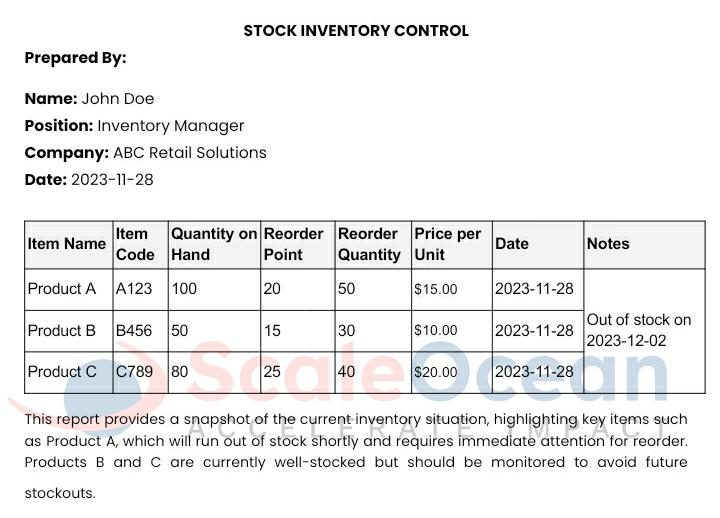
b. Barcode-Based Inventory Control System
Barcode-based inventory control uses barcode labels and scanners to automatically track stock. This method enhances the speed and accuracy of stock updates by scanning goods during purchases and restocking. It significantly reduces mistakes made during manual data entry, making processes more efficient, especially when dealing with large amounts of data.
Barcode scanning is commonly used in grocery stores and electronics retailers to keep track of things. The primary aim of barcode-based systems is to automate the inventory process, making it more efficient and precise. The system works by assigning each product a unique barcode that can be scanned to enter information into a centralized inventory database. Here’s an example of a barcode inventory tracking template:
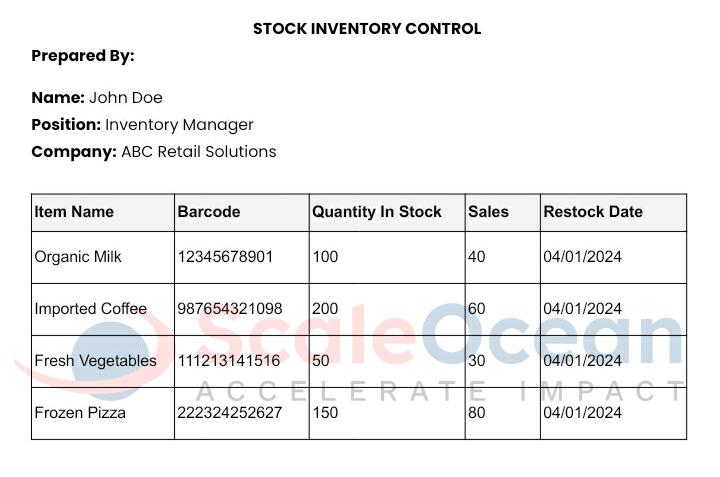
c. Radio Frequency Identification (RFID) System
RFID systems use electromagnetic fields to automatically recognize and track inventory items. Each product is equipped with an RFID tag, which sends data to a reader and updates the inventory system in real time. This technology improves inventory accuracy and enables thorough tracking of products throughout the supply chain. RFID is commonly utilized in large warehouses and industries that require high-accuracy tracking.
RFID systems function by attaching a small RFID chip to products or pallets, which are subsequently tracked by readers deployed throughout the supply chain. The system continuously updates inventory in real time, providing firms with a more accurate view of stock levels and movements. RFID tags could be used on objects like electronics or furniture in a warehouse to better track inventories and minimize losses. Here is an RFID inventory template:
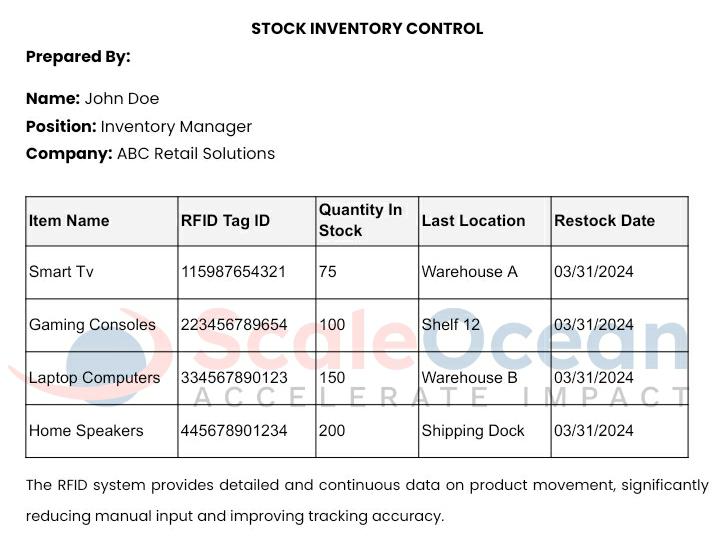
d. Just-in-Time (JIT) Inventory System
The JIT system reduces inventory by ordering only what is needed for production or sales. It reduces holding costs by ensuring that inventory matches demand. JIT depends on strong supplier relationships to ensure timely deliveries. This system is widely used in manufacturing and industries with high storage costs.
JIT inventory control enables organizations to reduce storage expenses and the risk of unsold items. Businesses that use precise demand forecasting can coordinate their purchasing and production cycles to maintain appropriate inventory levels. A car manufacturer may only order parts when a certain car model is in production. Here’s an example template for tracking JIT:
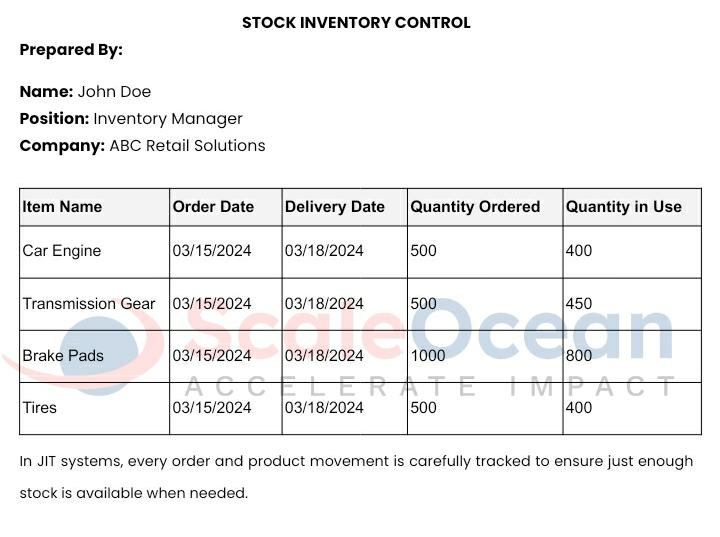
e. Economic Order Quantity (EOQ) System
EOQ is a formula for calculating the optimal order quantity that minimizes both ordering and holding expenses. By balancing the costs of ordering more product and keeping it in the warehouse, EOQ assists firms in maintaining optimal inventory levels. A retail chain may use EOQ to discover the most cost-effective order amounts for popular items.
EOQ enables firms to make informed purchasing decisions, resulting in more cost-effective inventory management. Businesses that precisely calculate order numbers can decrease surplus inventory and streamline purchasing cycles. For example, a wholesale distributor may utilize EOQ to calculate how much stock to order for different products in order to save holding costs. The EOQ formula frequently incorporates data from inventory templates to predict optimal order quantities:
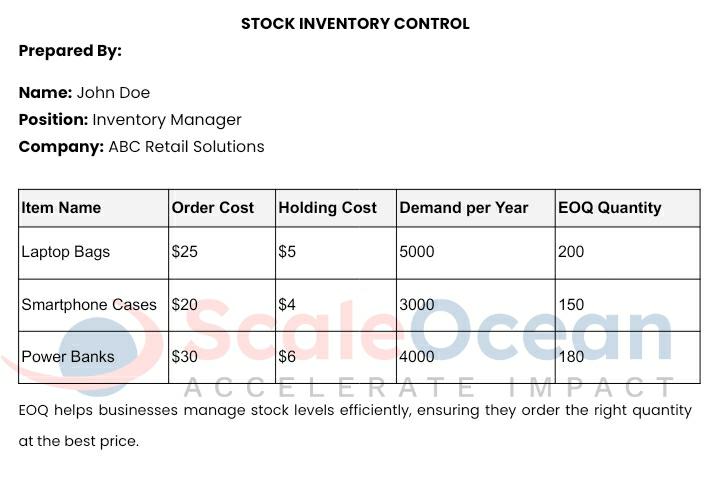
8. Tips to Streamline the Inventory Control Process
Effective inventory control is critical for organizations to meet consumer requests while eliminating surplus inventory. A well-organized system saves money and increases productivity, but maintaining inventory may be difficult, especially as firms develop. Businesses may improve inventory control, avoid stockouts, and overstocking by implementing the correct tactics and technologies.
Continuous monitoring, accurate forecasting, and cutting-edge technology are all required for effective inventory management. It is also critical to teach employees in proper practices and implement dependable tracking systems. Businesses can use these measures to maintain precise stock levels, increase customer happiness, and lower operational expenses. Here are some recommendations to help firms streamline their inventory control operations.
a. Implement Real-Time Inventory Tracking
Real-time inventory tracking is an essential method for efficient inventory management. Using tools like barcode scanners or RFID, companies can track their stock and products in real time, cutting down on manual mistakes. This ensures that inventory data is always up to date, making it easier to manage stock levels and eliminate discrepancies.
Furthermore, real-time tracking enables firms to respond swiftly to changes in demand and supply chain interruptions. If a product is running low or there is an unexpected increase in client demand, businesses can change their ordering and stock levels accordingly. This agility is essential in today’s fast-paced market, where delays can lead to lost sales and strained client relationships.
b. Utilize Inventory Forecasting Tools
Accurate forecasting is required for effective supply and demand management. Inventory forecasting technologies use past sales data, trends, and other factors to forecast future demand. Businesses can use these tools to minimize overstocking and understocking, as well as make smarter buying selections.
Forecasting allows organizations to plan for demand swings during seasonal peaks or promotional times. This guarantees that the proper amount of stock is available at the appropriate moment, lowering excess inventory and the danger of stockouts. Forecasting tools help increase cash flow by preventing excess money from being locked up in unsold inventory.
c. Optimize Stock Rotation
Proper stock rotation is critical to keeping products from becoming outmoded or expired, particularly in industries such as food and pharmaceuticals. Implementing inventory management techniques such as FIFO (First In, First Out) or LIFO (Last In, First Out) can assist ensure that older material is used first. This reduces waste and maximizes stock turnover.
Stock rotation not only reduces waste, but it also increases warehouse efficiency. Staff can swiftly access and disperse the oldest inventory, preventing stagnant inventories and enhancing product flow. This also helps to cut storage expenses by keeping stock fresh and in demand.
d. Streamline Supplier Relationships
Building solid, dependable connections with suppliers is critical for efficient inventory management. Poor supplier communication and inconsistent deliveries can cause delays and stockouts. Businesses may assure timely and regular inventory replenishment by communicating clearly and negotiating favorable terms.
Furthermore, having numerous sources or a backup plan in place might help to mitigate the risks associated with relying solely on one source. A diverse supplier base contributes to a consistent flow of goods and eliminates disruptions caused by supplier issues such as production delays or transportation problems.
e. Automate Inventory Management Systems
Automating inventory control systems can significantly increase efficiency and accuracy. With automated inventory tracking, businesses can say goodbye to manual data entry and reduce the risk of costly errors, leading to better inventory management and increased profitability. This results in more accurate records and fewer discrepancies in inventory reporting.
Automation also allows employees to devote more time to strategic duties like evaluating inventory trends or discovering cost-cutting options. Automation may greatly improve inventory management by decreasing manual processes, resulting in cost savings and more efficient operations.
f. Regularly Audit Inventory
Conducting regular inventory audits is critical for detecting inconsistencies between recorded and real inventory levels. Periodic audits can discover errors early, allowing organizations to address problems before they worsen. This also helps organizations keep accurate financial records and reduces the possibility of inventory shrinkage.
There are numerous ways for conducting inventory audits, including cycle counting and annual stocktakes. Regardless of the method, regular audits guarantee that the company understands its inventory situation and can make educated decisions about restocking and purchase.
g. Improve Warehouse Organization
Your warehouse’s organization is critical to improving inventory control. Properly labeled shelves, optimal storage layouts, and quick access to commonly sold items can all help to speed up order fulfillment and inventory checks. A well-organized warehouse saves time locating products and eliminates the possibility of errors during stocktaking.
Furthermore, employing a well-planned warehouse design can boost safety and productivity. A clutter-free, logically organized environment ensures that inventory is stored in the most effective manner, allowing employees to easily discover items and save time searching for products.
h. Monitor Inventory KPIs (Key Performance Indicators)
Tracking inventory KPIs such as turnover rates, order correctness, and stockout frequency is critical for determining the success of your inventory control procedures. Businesses that frequently analyze these data can find areas for improvement and alter their strategies as needed. For example, if stockouts occur frequently, it may highlight the need for better forecasting or more dependable suppliers.
Monitoring KPIs also helps organizations evaluate the financial success of their inventories. By tracking variables such as inventory carrying costs, firms may make data-driven decisions about how much stock to keep on hand and how to optimize inventory turnover for maximum profit.
9. Monitor Stock Status in Real-Time with ScaleOcean WMS Software
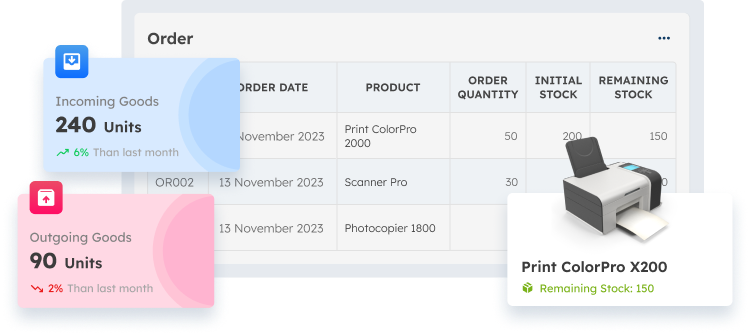
Efficient inventory management is a key difficulty for many firms, particularly when product volumes rise and the flow of items gets more complex. To overcome this, a trustworthy Warehouse Management System (WMS) is required. ScaleOcean offers a WMS solution that allows organizations to track stock status in real time, providing complete visibility of goods movement from warehouse to customer.
Businesses that use ScaleOcean’s WMS may prevent common concerns such as overstocking or understocking, which can have an impact on profitability and customer satisfaction. With ScaleOcean’s WMS, you can simply manage stock and provide more accurate data, allowing you to make smarter business decisions. The ScaleOcean WMS system has several major features, which are listed below.
- Real-Time Stock Monitoring, with WMS ScaleOcean provides businesses complete visibility into inventory, helping to balance supply and demand while preventing stockouts and overstocking. By integrating with Best ERP software singapore, ScaleOcean streamlines inventory and resource management for improved planning and decision-making.
- Automated Stock Recording, WMS ScaleOcean automates stock updates as goods are received or transported, eliminating manual tracking errors. This increases accuracy, speeds up inventory audits, and reduces the risk of mistakes.
- Low Stock Alerts, ScaleOcean WMS’ low stock alert feature automatically notifies businesses when inventory is low, allowing for quick reorders and preventing stockouts. This ensures smooth operations, avoids missed sales, and maintains product availability for customers.
- Multi-location Inventory Management, WMS ScaleOcean enables businesses to manage inventory across multiple locations on a single platform, providing a unified view of their stock. This centralized control helps optimize stock distribution, reduce shortages, and prevent excess inventory at different sites.
- Comprehensive Stock Reporting and Analytics, ScaleOcean provides detailed stock reporting and analytics, helping businesses track inventory levels, turnover rates, and stock movements for better decision-making. This data enables companies to optimize inventory, reduce surplus, and improve forecasting accuracy, leading to increased efficiency.
10. Conclusion
Good inventory control is critical for corporate success, and WMS ScaleOcean provides a reliable solution to streamline this process. Businesses can avoid costly concerns like stock outs or overstocking by using features such as real-time stock monitoring, automatic tracking, and detailed reporting. The system also enables multi-location management, which provides more control and visibility across all storage facilities.
ScaleOcean provides a free demo that allows you to see how the platform can improve your inventory control. ScaleOcean enables you to automate processes, decrease errors, and optimize stock levels, resulting in increased productivity and profitability. Take advantage of this opportunity to learn how ScaleOcean can improve your inventory management today.







 PTE LTD..png)
.png)

.png)








.png)
.png)
















